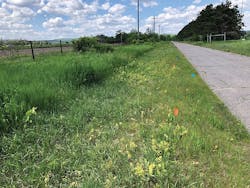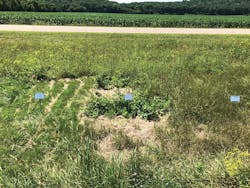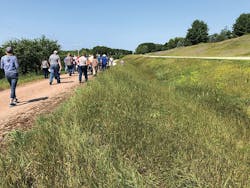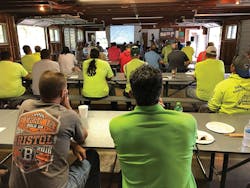By: Travis Rogers
In spring 2019, the Division of Extension at the University of Wisconsin-Madison launched a project to compare the effectiveness of management methods for three invasive plants across the state of Wisconsin. Supported by educational workshops, the results of this research have initiated change within the industry as roadside managers have refined their understanding of herbicide treatments and the many benefits they provide to vegetation management programs.
The management of invasive plants has long been a focus of roadside managers and supporting municipalities. As roadsides are a primary vector for the introduction and spread of invasive plants, municipal and county highway departments often rely on management methods like mowing to control undesirable species. When done properly, mowing can relieve impacted areas. However, this strategy presents several dangers to staff working on busy roadsides, and results can be inconsistent because time and knowledge are often as limited as equipment access and departmental funding.
Through the leadership of Dr. Mark Renz, professor and Extension weed specialist at the University of Wisconsin-Madison, the university’s Division of Extension began working with private industry practitioners and nonprofits in May 2019 to assess the effects of mowing and hand-removal methods compared with sites on which herbicide applications were used for vegetation management. This research focused on the control of three invasive plants found throughout Wisconsin and across many areas of the country: wild parsnip (Pastinaca sativa), wild chervil (Anthriscus sylvestris), and teasel (Dipsacus spp.).
With the help of 4 Control, a regional professional application company specializing in invasive plant control, UW-Madison launched the 2019 Roadside Workshop to improve safety, to protect adjacent habitats from invasive species, and to enhance awareness of the results and fiscal benefits herbicide treatments can provide to roadside managers.
“The goal of these workshops is to not only educate individuals on how to manage invasive plants on roadsides, but also challenge them to overcome obstacles and start adopting better management practices,” Renz said.
Treatment & Results
Over the course of two months, multiple treatments were tested on a number of small- and large-scale plots within Brown, Chippewa, Kenosha, Portage, and Sauk counties. Each workshop included numerous treatment methods and equipment as well as various rates and times of application. Mowing and hand-removal strategies were compared with herbicide-based management techniques on all sites, and a wider variety of treatments were included on small-scale plots. Regardless of the application site or invasive species targeted, herbicide treatments consistently demonstrated improved efficacy.
In addition to nearly eliminating parsnip and teasel rosettes through autumn of the application year, four different herbicides were shown to nearly eliminate teasel rosettes in that season, and three herbicides provided over 90% control of wild chervil for the entire growing season. Comparatively, mowing and hand-weeding methods failed to exceed 77% control of invasive plants in either season. Thus, the use of herbicides yielded significantly better results across the board for each species.
Recognizing the Difference
Along with the enhanced control of invasive plants, the use of herbicides was shown to reduce the cost of maintenance per application season. Estimated costs for hand-removal and mowing methods were $122 per acre and $70 to $150 per lane mile, respectively, and the average investment for herbicide treatments was substantially less for individual plant treatments ($13 to $87 per acre) or broadcast treatments ($12 to $65 per acre), which included the cost of application.
“Selective herbicides can help minimize invasive plant pressure to support the development of grasses and other desirable vegetation,” says John Kalthoff, vegetation management category leader with Corteva Agriscience. “As an added benefit, they do so at a much lower cost than mowing.”
Mechanical methods of control not only increase maintenance costs but also can fall short of the results achieved by selective herbicide applications. By only targeting incompatible plant species, selective herbicides are able to clear out noxious weeds and other invasive plants, which effectively creates an environment in which compatible plant communities can thrive. Although mowing practices can still supplement roadside management programs, short-term results often lead to more work down the line.
“Mowing is much more expensive than spraying herbicide,” Renz says. “What we find is mowing can be effective at preventing seed production and temporarily reducing cover of those plants, but control doesn’t persist through the fall.”
With herbicides enhancing control of invasive plants like wild chervil, wild parsnip, and teasel, invasive plant populations were shown to be significantly lower than mowing strategies by the fall.
Timing Is Everything
Mowing methods can support the control of incompatible species along roadsides, but they are most effective when timed correctly. As a primary contributor to the 2019 Roadside Workshop, Renz acknowledges the importance of achieving optimum results through prompt maintenance.
“We can prevent or severely reduce the spread of most invasive plants through well-timed mowing,” Renz says. “The challenge is timing. In many cases, there’s a two- to three-week window when it’s the ideal time to mow.”
Failure to mow at opportune times during each growing season can have adverse effects on vegetation management programs. Mowing too early can allow targeted vegetation to resprout and flower, which leads to viable seed production if not addressed by subsequent mowing. Conversely, mowing too late can inadvertently distribute seed along roadsides and lead to the spread of invasive species the following year.
With many municipalities relying on limited equipment to maintain thousands of miles of roadsides across Wisconsin, mowing practices alone can take up to two months to complete each mowing cycle, depending upon the size of each managed area. Timing plays an integral role in the success of vegetation management programs that rely on mowing alone, so the 2019 Roadside Workshop demonstrated alternative strategies that can improve vegetation management programs across the state—and nation.
Connecting With the Right Audience
Classroom training alone had failed to generate a shift in management strategies among state highway workers in recent years, so the 2019 Roadside Workshop complemented educational discussions with tours of test sites within each county. Representatives from municipalities, tribal governments, nonprofits, county staff, and state agencies were guided by Renz and workshop partners through local plots in which each application strategy was tested on the area’s most prevalent invasive species.
“We struggled getting townships and counties to buy in if they didn’t see the results,” says Lee Shambeau, owner of 4 Control. “Once they came on the tour and could see the results, it got them on board.”
To complement the impact of visual results displayed at each application site, workshop partners led classroom sessions to educate attendees on ways to address a general lack of funding. In referencing results generated by herbicide applications, roadside managers were encouraged to highlight long-term savings and approaches to repurposing those savings for an increase in other activities geared toward invasive plant control.
Surveying Industry Impact
In an effort to assess each workshop’s impact, Renz and team surveyed attendees upon the conclusion of each site tour and corresponding training session. Having received valuable insights regarding the beneficial use of herbicides for roadside management and recommendations for addressing funding needs, capacity limitations, or public participation, 93% of those surveyed expressed the intent to change their management methods as a result of the workshop.
“By doing five workshops, we found that those attending managed over 19,000 road miles in Wisconsin,” Renz said. “That’s 19% of our roads.”
Thanks to the 2019 Roadside Workshop, over 14,000 road miles managed across the state are now expected to have an improved mapping of invasive plants. Invasive species management plans, herbicide applications, and changes to management timing are projected to be applied to more than 12,000 road miles across the state as well.
In the wake of this notable success, there may be plans to increase learning opportunities for local and regional groups. Considering the optimum results generated by herbicide treatments throughout these studies, similar workshops and educational opportunities possess the propensity to influence decisions made by state legislators, DOTs, county staff, and/or local town boards.
“We’re looking to continue documenting the impact of the workshop, and may try to expand it through other parts of Wisconsin and beyond in the future,” Renz said.
About The Author: Rogers is with Market Development, Agriscience, for Corteva Agriscience.



